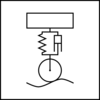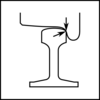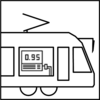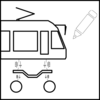Depending on the chosen course of study, the lecture and exercise are offered in German or English.

Rail Vehicle Vibration Dynamics
The lecture deals primarily with the description of the influence of vertical excitations from the track to the vehicle as a rigid body vibrational system and the evaluation of the vibration response with respect to driving safety, track damage, suspension design and riding comfort.
After an introduction, it is explained how and under which conditions vibration substitute models can be formed and simplified. Using the simplest substitute model of the single-mass oscillator, the solution approaches of free and forced oscillations known from mechanics are repeated. The understanding is deepened by numerous examples from vehicle engineering. The description of the track excitation follows before the common evaluation methods for the above-mentioned criteria are presented. The model is then extended to the two-mass oscillator before discussing vibration systems with nonlinear identification and improvement measures in ride comfort and safety.
Finally, a brief introduction to longitudinal vibrations excited by traction and braking follows.
Sfz II: lecture in German language (V2/Ü2)
Contact: Stefan.Lipinski, M.Sc.
RV II: lecture in English language (L2/E2)
Contact: Glunrawd.Chinnawit, M.Sc.

Track Guidance Technology
The track guidance represents the most important distinguishing characteristic between rail and road vehicles. The lecture deals with the function of the mechanical track guidance system wheel/rail. In particular, the aspects "safety against derailment", "running stability" and "wheel/rail wear" are adressed.
First, the geometries and relative positions of wheel and rail, wheelset and track, including switches and crossings are presented. The first concern with derailment safety is from a geometric point of view. Then the forces and moments in the wheel/rail contact are derived including various adhesion-slip theories. Then, the determination of safety against derailment at slow speeds in superelevated curves are dealt with. The horizontal motion behavior of the wheelset is first described purely kinematically.
Before the dynamic description of the wheelset motion is presented, the terms "equivalent conicity" and "effective wheel profile" are introduced. With the analysis of the motion behavior of the freely rolling wheelset, a derailment aspect can also be dealt with here, namely that of the critical speed. The same is then done for a pair of independent wheels. This is followed by the treatment of the curving behavior of the wheelset. After that, the running behaviors on tangent and curved tracks of various two-axle bogies are qualitatively discussed.
Finally, an introduction to the method of multibody system simulation is given and an insight into the standardized method of testing and proofing the safe running behavior of a train with the goal of homologation is presented.
Sfz III: lecture in German language (V2/Ü2)
Contact: Pascal Gil, M.Sc.
RV III: lecture in English language (V2/Ü2)
Contact: Pascal Gil, M.Sc.
Module: Applied Rail Vehicle Technology
From winter term 2018/19 the module "Applied Rail Vehicle Technology" is offered.
The module is comprised of two parts:

Part 1: Vehicle Systems and Components
This course deals with a presentation and a discussion on the most important systems and components rail vehicles consist of. The focus lies on locomotives, single and multiple units and passenger coaches. Starting with the largest subsystem, the car body, for which there are numbers of different construction methods which are briefly described in terms of designs, materials and joint technologies. Additionally, an overview of the most important attachments, such as front/ends and their equipment, buffers an couplers and articulation devices is given.
The running gear, as the mechanically most important and complex subsystem of the rail vehicle, is then discussed in detail. A wide variety of designs are covered according to application and due to track guidance and traction. Important running gear assemblies and components, such as the frame, suspensions, wheelset guidance, drive fixation and connection to the car body are then presented. Finally, the wheelset and the pair of independent wheels are discussed. The course concludes with the traction and brake equipment as other important subsystems.
Sfz IV, Part 1: lecture in German language (V2/Ü0)
Contact: Jannik Goersch, M.Sc.

Part 2: Railway vehicle technology laboratory
This course deals with a presentation and a discussion on the most important systems and components rail vehicles consist of. The focus lies on locomotives, single and multiple units and passenger coaches. Starting with the largest subsystem, the car body, for which there are numbers of different construction methods which are briefly described in terms of designs, materials and joint technologies. Additionally, an overview of the most important attachments, such as front/ends and their equipment, buffers an couplers and articulation devices is given.
The running gear, as the mechanically most important and complex subsystem of the rail vehicle, is then discussed in detail. A wide variety of designs are covered according to application and due to track guidance and traction. Important running gear assemblies and components, such as the frame, suspensions, wheelset guidance, drive fixation and connection to the car body are then presented. Finally, the wheelset and the pair of independent wheels are discussed. The course concludes with the traction and brake equipment as other important subsystems.
Sfz IV, Part 2: exercise in German language (V0/Ü2)
Contact: Jannik Goersch, M.Sc.

Product Development in Rail Vehicle Engineering
The special features of the rail vehicle product as a capital good in contrast to the consumer good motor vehicle are elaborated. This is followed by an overview of the usual product life cycle process in the rail vehicle industry, starting with the Europe-wide invitation to tender by the mostly publicly owned transport companies. Then a description of the project processing of a rail vehicle order with the manufacturer is given. In particular, the aspects of project management and product development are highlighted. Frequent reference is made to common product development methods, such as those according to VDI Guidelines 2206 and 2221, and their most important contents are discussed with reference to the rail vehicle product.
In the further course, the basics of project management, such as project team composition, project controlling, cost and risk management are dealt with. Measures to increase efficiency in engineering and to hedge risks are also presented before the downstream but very important processes of approval and commissioning are discussed.
Sfz V: lecture in German language (V2/Ü2)
Contact: Nils.Jendrny, M.Sc. RWTH

Structural Integrity of Railway Vehicles (Sfz VI), V1/Ü0
Ensuring the strength of the load-bearing components of a rail vehicle is one of the most important tasks in the development of these products. In particular, the market requirement that the load-bearing structures must serve for at least 30 years without significant failure places high demands on wheelsets, bogie frames and car bodies. The wheelsets must be designed for 'safe life' in any case, as there is no fallback level. In addition to the design against rare very high quasi-static loads and permanently occurring fatigue loads, the car body must also be designed to be collision-proof.
This course initially focuses on the strength and collision safety-compliant design of the car body and the corresponding verification procedure, as well as the strength design of the chassis frame and wheelsets.
Lecture in German language.
Lecturer: Dr. Burkhard Arras, Siemens Mobility GmbH, Krefeld and Dr. Alois Starlinger, Stadler Rheintal Ag, St. Margarethen, Suisse
Contact: Jannik.Goersch, M.Sc.
Digitalization in Rail Vehicle Technology (Sfz VII)

The lecture "Digitalization in Rail Vehicle Technology" (discusses current trends, challenges, and prospects of digitalization of railways.
It is comprised of lectures, guest lectures from leading industry experts as well as seminars, where students present and discuss their findings regarding a self-chosen topic related to the courses content. Alternatively, the students can choose from a handful of pre-selected presentation topics.
In addition to the presentation a short seminar paper must be submitted by the end of the course accompanying the student's presentations. Beneath teaching students about digitalization in the railway environments the students have the chance to improve their presentation and scientific writing skills. Both the presentation and the seminar paper make up the final grade. The course is intended for a group size of up to 20 students.
Ansprechpartner: Philipp Leibner, M.Sc
Dates of the offered modules
Current lecture and exercise dates
The lecture and exercise dates of all courses from IFS for the current semester can be found in RWTHonline at:
https://online.rwth-aachen.de/RWTHonline/webnav.navigate_to?corg=14437

